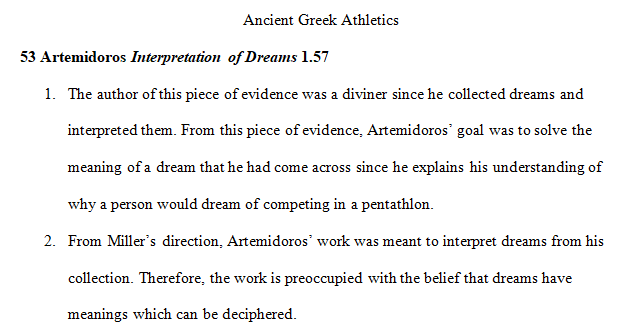
Using the “Index and Glossary” at the back of Arete (pp. 209–233), choose a headword with at least three related entries
Ancient Greek Athletics
OVERVIEW: The aim of this assignment is to assist students in becoming sophisticated and critical readers of the sourcebook, Arete. Understanding the historical, literary, and political contexts of ancient evidence, students will become sensitive not only to the materials potential biases, but also its nuances of emphasis and detail.
A second goal is to allow students to dive deep into a topic of their choosing. The more invested the student is in knowing about the person/place/event/object in question, the better. This has the potential to be not only enlightening, but also fun.
INSTRUCTIONS:
- Using the “Index and Glossary” at the back of Arete (pp. 209–233), choose a headword with at least three related entries (i.e., numbers in bold at the end of the entry). This may be a person, place, event, or object. You may want to try out several headwords before you commit to one you find particularly interesting and well-suited to this assignment.
- Read all entries related to this headword closely—ideally, several times. Then, choose three, and only three, entires that seem together to give what is to you the most interesting perspective on the headword in question. It may be that your three entries may be from a similar era, offering a synchronic perspective on the issue, or else from widely different sources across space and time. Please avoid taking all three of your three pieces of evidence from the same author (e.g., Galen, Pausanias, Philostratus, etc.).
- The Report: In a typed document, please provide the following information for each of your three entries, prominently providing the Arete number for reference. Please also make reference to the following enumeration (parts 1–5) in your report, but details of formatting (line-spacing, font size, etc.) are up to you.
- In two or three sentences, describe the author or evidence used: What can you discover about the author’s background (language, ethnicity, class, profession, age, gender, etc.). Does s/he (although it is often he) have a particular bias, goal, framework when writing? If the evidence is inscriptional, without a clear sole author, what can you say about its context?
- Where applicable, offer a one to two sentence summary of the specific work in question (given by Miller in italics): What is the work’s ostensible audience and/or goal? What omissions/preoccupations might you infer?
- In one to two sentences, summarize in broad strokes the relevant geopolitical background of Greek athletics at the time/place the evidence was written. Is this piece of evidence from archaic or classical Greece (~776–322 BCE), the so-called Hellenistic era (~322–31 BCE), or the era of the Roman empire? (~31BCE to the end of antiquity). Where applicable, how much time separates your evidence from the event(s) it describes?
- In one to two sentences, summarize the content of the evidence: What is being discussed/argued/proclaimed
- Then, taking as much space as you need, discuss what is interesting or distinctive about the evidence, particularly insofar as it contributes to your understanding of the chosen headword.
Finally, provide a paragraph synopsis that synthesizes the chosen three pieces of evidence. Please address in particular: (a) Does the evidence paint a coherent, or contradictory, picture? (b) Is this (in)coherence affected by issues of date, ethnicity, religious belief, etc. — and if so, how? (c) How does this evidence contribute to our overall understanding of ancient Greek athletics?
LENGTH REQUREMENTS
The entire assignment should run at least 2–3 pages in length. While students are encouraged to delve deeply into material they find interesting, they should also be judicious in crafting a report that lays clear emphasizes on the most salient details and avoids rambling. As a general rule, students who have written five or more pages should consider becoming selective and concise in their presentation of facts and analysis.
THE WORD IS “DROMOS”
DEFINITION AND ENTRIES ARE BELOW! MUST ONLY PICK 3 ENTRIES!
REQUIREMENTS
University of North Carolina at Chapel Hill
Answer preview…………………….

apa 782 words